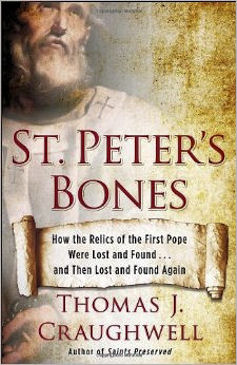
|
Posted November 5, 2014
Book: St. Peter's Bones: How the relics of the first pope were lost and found . . . . and then lost and found again Author: Thomas J. Craughwell Image. New York. 2014. Pp. 126 An Excerpt from the Jacket:
In 1448 a team of architects and engineers brought Pope Nicholas V unhappy news: the 1100-old Basilica of St. Peter suffered from so many structural defects that it was beyond repair. The only solution was to pull down the old church --- one of the most venerable churches in Christendom --- and erect a new basilica on the site. Incredibly, one of the tombs the builders paved over was the resting place of St. Peter. Then 1939, while working underground in the Vatican, one workman's shovel struck not dirt or rock but open air. The diggers shone a flashlight through the opening and saw a portion of an ancient Christian mausoleum. An archaeologist was summoned at once and after inspect what could be seen through the hole the diggers had made in the mausoleum's roof, he authorized a full-scale excavation. What lay beneath? The answer and the adventure await. An Excerpt from the Book: Today the Scavi, ("the Excavations"), as the Vatican Necropolis has come to be called, is open to visitors, but not many. Groups are limited to 15, children younger than twelve are not admitted, and tickets must be reserved months in advance. As a result of these restrictions, it is a rare day than more than 250 fortunate individuals see one of the most remarkable sites in Rome. Compare that miniscule number to the thousands who throng the Basilica of St. Peter and the Vatican Museums nearby. But the restrictions are necessary for two reasons. First, the tombs, the graves, the carvings, the frescoes, and all the other artifacts are fragile; large crowds moving among these ancient structures would do some damage, but small groups of mature adolescents and adults are easier to control. Second, at the heart of the Scavi is a shrine --- the tomb of St. Peter, with his relics displayed within. This is holy ground, and once again, crowds of tourist or even well-intentioned religious pilgrims would undermine the solemnity of this place. To visit the Scavi is to leave twenty-first-century Rome behind and step into first-century Rome. The atmosphere is damp --- nothing can be done about that; to preserve the frescoes from fading, the lighting is subdued. The tour takes about ninety minutes, led by a guide who is extremely well informed about the Scavi. The tour concludes at the tomb of St. Peter. George Weigel, writing of his visit to the Scavi, said, "What we've just seen and touched and smell is about as close to the apostolic roots of the Catholic Church as it's possible to get." |
|
